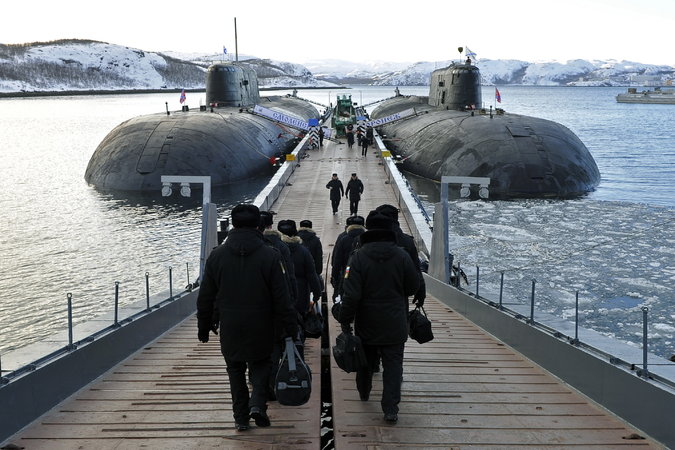
RUSSIA BOLSTERS ITS SUBMARINE FLEET, AND TENSIONS WITH U.S. RISE
Eric Schmitt
(SCROLL DOWN)
*
*
*
*
*
*
*
*
*
*

NAPLES, Italy — Russian attack submarines, the most in two decades, are prowling the coastlines of Scandinavia and Scotland, the Mediterranean Sea and the North Atlantic in what Western military officials say is a significantly increased presence aimed at contesting American and NATO undersea dominance.
Adm. Mark Ferguson, the United States Navy’s top commander in Europe, said last fall that the intensity of Russian submarine patrols had risen by almost 50 percent over the past year, citing public remarks by the Russian Navy chief, Adm. Viktor Chirkov. Analysts say that tempo has not changed since then.
The patrols are the most visible sign of a renewed interest in submarine warfare by President Vladimir V. Putin, whose government has spent billions of dollars for new classes of diesel and nuclear-powered attack submarines that are quieter, better armed and operated by more proficient crews than in the past.
The tensions are part of an expanding rivalry and military buildup, with echoes of the Cold War, between the United States and Russia. Moscow is projecting force not only in the North Atlantic but also in Syria and Ukraine and building up its nuclear arsenal and cyberwarfare capacities in what American military officials say is an attempt to prove its relevance after years of economic decline and retrenchment.
Independent American military analysts see the increased Russian submarine patrols as a legitimate challenge to the United States and NATO. Even short of tensions, there is the possibility of accidents and miscalculations. But whatever the threat, the Pentagon is also using the stepped-up Russian patrols as another argument for bigger budgets for submarines and anti-submarine warfare.

American naval officials say that in the short term, the growing number of Russian submarines, with their ability to shadow Western vessels and European coastlines, will require more ships, planes and subs to monitor them. In the long term, the Defense Department has proposed $8.1 billion over the next five years for “undersea capabilities,” including nine new Virginia-class attack submarines that can carry up to 40 Tomahawk cruise missiles, more than triple the capacity now.
“We’re back to the great powers competition,” Adm. John M. Richardson, the chief of naval operations, said in an interview.
Last week, unarmed Russian warplanes repeatedly buzzed a Navy destroyer in the Baltic Sea and at one point came within 30 feet of the warship American officials said. Last year some of Russia’s new diesel submarines launched four cruise missiles at targets in Syria.
To be sure, there is hardly parity between the Russian and American submarine fleets. Russia has about 45 attack submarines — about two dozen are nuclear-powered and 20 are diesel — which are designed to sink other submarines or ships, collect intelligence and conduct patrols. But Western naval analysts say that only about half of those are able to deploy at any given time. Most stay closer to home and maintain an operational tempo far below a Cold War peak.
s has 53 attack submarines, all nuclear-powered, as well as four other nuclear-powered submarines that carry cruise missiles and Special Operations forces. At any given time, roughly a third of America’s attack submarines are at sea, either on patrols or training, with the others undergoing maintenance. American Navy officials and Western analysts say that American attack submarines, which are made for speed, endurance and stealth to deploy far from American shores, remain superior to their Russian counterparts.
The Pentagon is also developing sophisticated technology to monitor encrypted communications from Russian submarines and new kinds of remotely controlled or autonomous vessels. Members of the NATO alliance, including Britain, Germany and Norway, are at the same time buying or considering buying new submarines in response to the Kremlin’s projection of force in the Baltic and Arctic.
But Moscow’s recently revised national security and maritime strategies emphasize the need for Russian maritime forces to project power and to have access to the broader Atlantic Ocean as well as the Arctic.
Russian submarines and spy ships now operate near the vital undersea cables that carry almost all global Internet communications, raising concerns among some American military and intelligence officials that the Russians could attack those lines in times of tension or conflict. Russia is also building an undersea unmanned drone capable of carrying a small, tactical nuclear weapon to use against harbors or coastal areas, American military and intelligence analysts said.
And, like the United States, Russia operates larger nuclear-powered submarines that carry long-range nuclear missiles and spend months at a time hiding in the depths of the ocean. Those submarines, although lethal, do not patrol like the attack submarines do, and do not pose the same degree of concern to American Naval officials.
http://www.nytimes.com/2016/04/21/world/europe/russia-bolsters-submarine-fleet-and-tensions-with-us-rise.html?emc=edit_th_20160421&nl=todaysheadlines&nlid=65730323&_r=0
